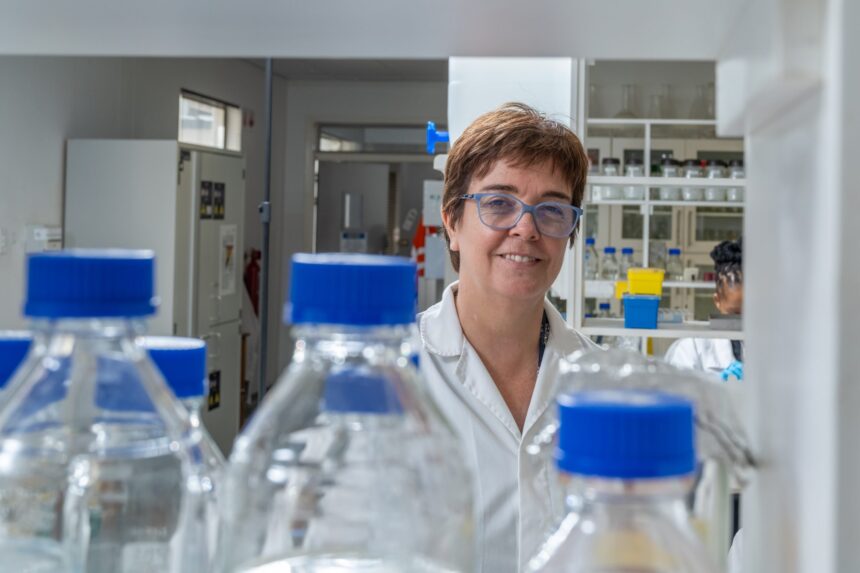Fungal infections affect more than one billion people each year, of which more than 150 million cases are severe and life-threatening, causing 1.7 million deaths a year. In South Africa it is estimated that diseases caused by fungal infections total more than three million cases a year. These figures are especially shocking given that prior to 1980, fungal infections were not a major health problem.
“The WHO has recently published a list of priority pathogens in which fungi are classified in critical, high- and medium- priority groups. Candida species are found in all three levels and Cryptococcus species in critical and medium groups,” says Prof Pohl-Albertyn.
It is for these reasons that researchers in the Department of Microbiology and Biochemistry at the University of the Free State (UFS) are working on various research projects investigating new treatment options beyond the established antifungals. Prof Carlien Pohl-Albertyn, National Research Forum (NRF) SARChI Research Chair in Pathogenic Yeasts, leads the team that is working on various research projects relating to fungi casing yeast.
Multidrug-resistant yeast
One of the yeasts being researched is Candida auris – a multidrug-resistant yeast that can cause severe infections in humans, particularly in people who are hospitalised or have weakened immune systems. C. auris was first identified in 2009 in Japan and has since been reported in over 49 countries.
According to Prof Pohl-Albertyn, C. auris is of concern because it is often resistant to multiple antifungal drugs, making it difficult to treat. In addition, it can survive on surfaces in healthcare settings, which can contribute to its spread between patients, causing outbreaks in hospitals. “Due to its multidrug resistance and potential for transmission, C. auris has been designated by the Centers for Disease Control and Prevention (CDC) as a serious global health threat and listed as the second most critical fungal pathogen in the World Health Organisation (WHO) fungal critical priority group.
“C. auris possesses virulence factors such as increased thermotolerance, high salinity tolerance, biofilm formation, and extra cellular enzyme secretion, which are the major contributing factors to its multidrug resistance profile and virulence. Even though C. auris has a variety of virulence factors that it employs against its human host to develop an infection, its virulence mechanisms remain unclear,” says Prof Pohl-Albertyn
Therefore, several research projects investigate this pathogenic yeast. All of them started with the development of CRISP-Cas9 gene editing tools for this yeast, in order to be able to delete specific genes in this yeast to study their roles. These tools are also constantly being improved for greater efficiency by students under the supervision of Prof Jacobus Albertyn. Two current projects deal with the function of specific secreted enzymes in the virulence of C. auris.
Environmental yeast
Another yeast being researched, under the supervision of Prof Olihile Sebolai, is Cryptococcus neoformans, an environmental yeast found in trees and soil contaminated with bird droppings. Moreover, it can be airborne and when inhaled it lodges in the lungs (in alveoli) and can cause primary lung infection, explains Prof Pohl-Albertyn.
Cryptococcus neoformans causes AIDS-defining illnesses in people living with HIV/AIDS. To the point, it was not surprising when the WHO declared it as the first critical fungal pathogen of concern. Dissemination to other organs has been reported where it crosses the epithelium barrier by secreting proteases (a class of enzymes that break down proteins in the host) that compromise the tight junctions between the epithelial cells.
The current projects investigate the interaction between the proteases secreted by C. neoformans and co-infecting viruses, such as SARS-CoV-2 and influenza. The SARS-CoV-2 virus is activated by proteases in the host and proteases also help the influenza virus to enter and infect the host cells. Since the host proteases are similar to those secreted by C. neoformans, these projects are focused on determining if the yeast proteases can also help the viruses to cause infection. This project is also extended to study Candida albicans proteases as this is also a common co-infecting yeast in COVID-19 patients (for more detail on C. albicans).
Another project looks at the application of plants as sources for novel drugs against C. neoformans. This is important since 75-80% of African and Asian populations still rely on traditional or complementary/alternative medicines for their primary health-care needs. Coupled to this, modern medicines have become increasingly expensive and thus inaccessible to many in developing countries. Moreover, there is a shift to more “organic” and “vegan” lifestyles as well as the use of herbal medicines to prevent or manage the development of certain diseases.
Yeast contaminated water
“Considering the severity of invasive fungal infection, it is important to study the dissemination and proliferation of various pathogenic or potentially pathogenic fungal species in our surrounding environments. It is crucial to identify major vectors that aid in the spread of pathogenic yeast to prevent infections in susceptible individuals, which mainly include immunocompromised or immunosuppressed individuals.
“Candida, Cryptococcus and Rhodotorula species are commonly found in a variety of water sources with which humans are in frequent contact through daily activities like bathing, washing of clothes and cooking. This recent information further warrants the investigation into the possibility that fungal infections may occur through contact with yeast contaminated water,” concludes Prof Pohl-Albertyn.
She says it is thus important to investigate the presence and antifungal susceptibility of yeast found in water as well as to identify ways to monitor potential fungal outbreaks, possibly through wastewater surveillance. The research aims to identify potentially pathogenic yeast species as well as to quantify levels of azole, specifically fluconazole, in wastewater. In addition, the fluconazole susceptibility of these isolates will be assessed in an attempt to link azole pollution of the environment to antifungal drug resistance development.



Leave a Reply